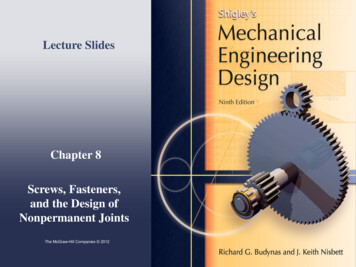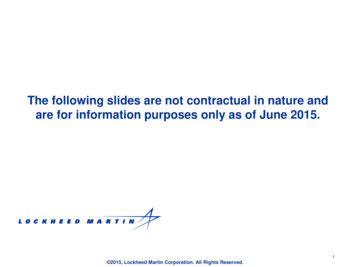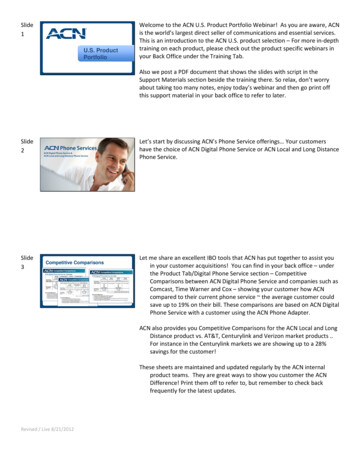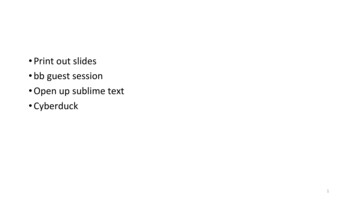
Transcription
Lecture SlidesChapter 8Screws, Fasteners,and the Design ofNonpermanent JointsThe McGraw-Hill Companies 2012
Chapter OutlineShigley’s Mechanical Engineering Design
Reasons for Non-permanent FastenersField assembly Disassembly Maintenance Adjustment Shigley’s Mechanical Engineering Design
Thread Standards and DefinitionsPitch – distance betweenadjacent threads.Reciprocal of threads perinch Major diameter – largestdiameter of thread Minor diameter –smallest diameter ofthread Pitch diameter –theoretical diameterbetween major andminor diameters, wheretooth and gap are samewidth Fig. 8–1Shigley’s Mechanical Engineering Design
Standardization The American National (Unified) thread standard definesbasic thread geometry for uniformity and interchangeability American National (Unified) thread UNnormal thread UNR greater root radius for fatigue applications Metric thread M series (normal thread) MJ series (greater root radius)Shigley’s Mechanical Engineering Design
Standardization Coarse series UNC General assembly Frequent disassembly Not good for vibrations The “normal” thread to specify Fine series UNF Good for vibrations Good for adjustments Automotive and aircraft Extra Fine series UNEF Good for shock and large vibrations High grade alloy Instrumentation AircraftShigley’s Mechanical Engineering Design
Standardization Basic profile for metric M and MJ threads shown in Fig. 8–2Tables 8–1 and 8–2 define basic dimensions for standard threadsFig. 8–2Shigley’s Mechanical Engineering Design
Diameters and Areas for Metric Threads
Diameters and Areas for Unified Screw ThreadsTable 8–2
Tensile Stress Area The tensile stress area, At , is the area of an unthreaded rodwith the same tensile strength as a threaded rod. It is the effective area of a threaded rod to be used for stresscalculations. The diameter of this unthreaded rod is the average of thepitch diameter and the minor diameter of the threaded rod.Shigley’s Mechanical Engineering Design
Square and Acme Threads Square and Acme threads are used when the threads are intended totransmit powerFig. 8–3Table 8-3 Preferred Pitches for Acme ThreadsShigley’s Mechanical Engineering Design
Mechanics of Power Screws Power screw Used to change angular motion intolinear motion Usually transmits power Examples include vises, presses,jacks, lead screw on latheFig. 8–4Shigley’s Mechanical Engineering Design
Mechanics of Power ScrewsFind expression for torque required toraise or lower a load Unroll one turn of a thread Treat thread as inclined plane Do force analysis Fig. 8–5Fig. 8–6Shigley’s Mechanical Engineering Design
Mechanics of Power Screws For raising the load For lowering the loadFig. 8–6Shigley’s Mechanical Engineering Design
Mechanics of Power Screws Eliminate N and solve for P to raise and lower the load Divide numerator and denominator by cosl and use relationtanl l /p dmShigley’s Mechanical Engineering Design
Raising and Lowering Torque Noting that the torque is the product of the force and the meanradius,Shigley’s Mechanical Engineering Design
Self-locking Condition If the lowering torque is negative, the load will lower itself bycausing the screw to spin without any external effort.If the lowering torque is positive, the screw is self-locking.Self-locking condition is p f dm lNoting that l / p dm tan l, the self-locking condition can beseen to only involve the coefficient of friction and the leadangle.Shigley’s Mechanical Engineering Design
Power Screw Efficiency The torque needed to raise the load with no friction losses canbe found from Eq. (8–1) with f 0. The efficiency of the power screw is thereforeShigley’s Mechanical Engineering Design
Power Screws with Acme Threads If Acme threads are used instead of squarethreads, the thread angle creates a wedgingaction.The friction components are increased.The torque necessary to raise a load (ortighten a screw) is found by dividing thefriction terms in Eq. (8–1) by cosa.Fig. 8–7Shigley’s Mechanical Engineering Design
Collar Friction An additional component oftorque is often needed toaccount for the frictionbetween a collar and the load.Assuming the load isconcentrated at the meancollar diameter dcFig. 8–7Shigley’s Mechanical Engineering Design
Thread Deformation in Screw-Nut CombinationPower screw thread is in compression, causing elastic shorteningof screw thread pitch. Engaging nut is in tension, causing elastic lengthening of the nutthread pitch. Consequently, the engaged threads cannot share the load equally. Experiments indicate the first thread carries 38% of the load, thesecond thread 25%, and the third thread 18%. The sevenththread is free of load. To find the largest stress in the first thread of a screw-nutcombination, use 0.38F in place of F, and set nt 1. Shigley’s Mechanical Engineering Design
Example 8-1Fig. 8–4Shigley’s Mechanical Engineering Design
Example 8-1Fig. 8–3aShigley’s Mechanical Engineering Design
Example 8-1Shigley’s Mechanical Engineering Design
Example 8-1Shigley’s Mechanical Engineering Design
Example 8-1Shigley’s Mechanical Engineering Design
Example 8-1Shigley’s Mechanical Engineering Design
Example 8-1Shigley’s Mechanical Engineering Design
Example 8-1Shigley’s Mechanical Engineering Design
Power Screw Safe Bearing PressureShigley’s Mechanical Engineering Design
Power Screw Friction CoefficientsShigley’s Mechanical Engineering Design
Head Type of BoltsHexagon head bolt Usually uses nut Heavy duty Hexagon head cap screw Thinner head Often used as screw (inthreaded hole, without nut) Socket head cap screw Usually more precisionapplications Access from the top Machine screws Usually smaller sizes Slot or philips head common Threaded all the way Fig. 8–9Fig. 8–10Shigley’s Mechanical Engineering Design
Machine ScrewsFig. 8–11Shigley’s Mechanical Engineering Design
Hexagon-Head BoltHexagon-head bolts are one of the most common for engineeringapplications Standard dimensions are included in Table A–29 W is usually about 1.5 times nominal diameter Bolt length L is measured from below the head Shigley’s Mechanical Engineering Design
Threaded LengthsEnglishMetricShigley’s Mechanical Engineering Design
NutsSee Appendix A–31 for typical specifications First three threads of nut carry majority of load Localized plastic strain in the first thread is likely, so nuts shouldnot be re-used in critical applications. End viewWasher-faced,regularChamfered both Washer-faced,sides, regularjam nutFig. 8–12Chamferedboth sides,jam nutShigley’s Mechanical Engineering Design
Tension Loaded Bolted Joint Grip length l includeseverything being compressedby bolt preload, includingwashersWasher under head preventsburrs at the hole fromgouging into the fillet underthe bolt headFig. 8–13Shigley’s Mechanical Engineering Design
Pressure Vessel Head Hex-head cap screw intapped hole used to fastencylinder head to cylinderbodyNote O-ring seal, notaffecting the stiffness of themembers within the gripOnly part of the threadedlength of the bolt contributesto the effective grip lFig. 8–14Shigley’s Mechanical Engineering Design
Effective Grip Length for Tapped Holes For screw in tapped hole,effective grip length isShigley’s Mechanical Engineering Design
Bolted Joint Stiffnesses During bolt preload bolt is stretched members in grip arecompressedWhen external load P isapplied Bolt stretches further Members in gripuncompress someJoint can be modeled as asoft bolt spring in parallelwith a stiff member springFig. 8–13Shigley’s Mechanical Engineering Design
Bolt Stiffness Axially loaded rod,partly threaded andpartly unthreadedConsider each portion asa springCombine as two springsin seriesShigley’s Mechanical Engineering Design
Procedure to Find Bolt StiffnessShigley’s Mechanical Engineering Design
Procedure to Find Bolt StiffnessShigley’s Mechanical Engineering Design
Procedure to Find Bolt StiffnessShigley’s Mechanical Engineering Design
Member StiffnessStress distribution spreads from face ofbolt head and nut Model as a cone with top cut off Called a frustum Shigley’s Mechanical Engineering Design
Member StiffnessModel compressed members as if they are frusta spreadingfrom the bolt head and nut to the midpoint of the grip Each frustum has a half-apex angle of a Find stiffness for frustum in compression Fig. 8–15Shigley’s Mechanical Engineering Design
Member StiffnessShigley’s Mechanical Engineering Design
Member Stiffness With typical value of a 30º,Use Eq. (8–20) to find stiffness for each frustum Combine all frusta as springs in series Fig. 8–15bShigley’s Mechanical Engineering Design
Member Stiffness for Common Material in Grip If the grip consists of any number of members all of the samematerial, two identical frusta can be added in series. The entirejoint can be handled with one equation, dw is the washer face diameterUsing standard washer face diameter of 1.5d, and with a 30º, Shigley’s Mechanical Engineering Design
Finite Element Approach to Member Stiffness For the special case of common material within the grip, a finiteelement model agrees with the frustum modelFig. 8–16Shigley’s Mechanical Engineering Design
Finite Element Approach to Member Stiffness Exponential curve-fit of finite element results can be used forcase of common material within the gripShigley’s Mechanical Engineering Design
Bolt Materials Grades specify material, heat treatment, strengths Table 8–9 for SAE grades Table 8–10 for ASTM designations Table 8–11 for metric property classGrades should be marked on head of boltShigley’s Mechanical Engineering Design
Bolt Materials Proof load is the maximum load thata bolt can withstand withoutacquiring a permanent setProof strength is the quotient of proofload and tensile-stress area Corresponds to proportional limit Slightly lower than yield strength Typically used for static strength ofboltGood bolt materials have stress-straincurve that continues to rise to fractureFig. 8–18Shigley’s Mechanical Engineering Design
SAE Specifications for Steel BoltsTable 8–9Shigley’s Mechanical Engineering Design
ASTM Specification for Steel BoltsTable 8–10Shigley’s Mechanical Engineering Design
Metric Mechanical-Property Classes for Steel BoltsTable 8–11Shigley’s Mechanical Engineering Design
Bolt SpecificationMaterial gradeThreads per inchThread series¼-20 x ¾ in UNC-2 Grade 5 Hex head boltNominal diameterlengthClass fitHead typePitchMetricM12 x 1.75 ISO 4.8 Hex head boltNominal diameterMaterial classShigley’s Mechanical Engineering Design
Tension Loaded Bolted JointsShigley’s Mechanical Engineering Design
Tension Loaded Bolted Joints During bolt preload bolt is stretched members in grip are compressedWhen external load P is applied Bolt stretches an additionalamount d Members in grip uncompress sameamount dFig. 8–13Shigley’s Mechanical Engineering Design
Stiffness Constant Since P Pb Pm, C is defined as the stiffness constant of the joint C indicates the proportion of external load P that the bolt willcarry. A good design target is around 0.2.Shigley’s Mechanical Engineering Design
Bolt and Member Loads The resultant bolt load is The resultant load on the members is These results are only valid if the load on the members remainsnegative, indicating the members stay in compression.Shigley’s Mechanical Engineering Design
Relating Bolt Torque to Bolt Tension Best way to measure bolt preload is by relating measured boltelongation and calculated stiffnessUsually, measuring bolt elongation is not practicalMeasuring applied torque is common, using a torque wrenchNeed to find relation between applied torque and bolt preloadShigley’s Mechanical Engineering Design
Relating Bolt Torque to Bolt Tension From the power screw equations, Eqs. (8–5) and (8–6), we get Applying tanl l/pdm, Assuming a washer face diameter of 1.5d, the collar diameter isdc (d 1.5d)/2 1.25d, givingShigley’s Mechanical Engineering Design
Relating Bolt Torque to Bolt Tension Define term in brackets as torque coefficient KShigley’s Mechanical Engineering Design
Typical Values for Torque Coefficient K Some recommended values for K for various bolt finishes isgiven in Table 8–15Use K 0.2 for other casesShigley’s Mechanical Engineering Design
Distribution of Preload vs Torque Measured preloads for 20 tests at same torque have considerablevariation Mean value of 34.3 kN Standard deviation of 4.91Table 8–13Shigley’s Mechanical Engineering Design
Distribution of Preload vs Torque Same test with lubricated bolts Mean value of 34.18 kN (unlubricated 34.3 kN) Standard deviation of 2.88 kN (unlubricated 4.91 kN)Table 8–14 Lubrication made little change to average preload vs torqueLubrication significantly reduces the standard deviation ofpreload vs torqueShigley’s Mechanical Engineering Design
Tension Loaded Bolted Joints: Static Factors of SafetyAxial Stress:Yielding Factor of Safety:Load Factor:Joint Separation Factor:Shigley’s Mechanical Engineering Design
Recommended PreloadShigley’s Mechanical Engineering Design
Fatigue Loading of Tension JointsFatigue methods of Ch. 6 are directly applicable Distribution of typical bolt failures is 15% under the head 20% at the end of the thread 65% in the thread at the nut face Fatigue stress-concentration factors for threads and fillet aregiven in Table 8–16 Shigley’s Mechanical Engineering Design
Endurance Strength for Bolts Bolts are standardized, so endurance strengths are known byexperimentation, including all modifiers. See Table 8–17.Fatigue stress-concentration factor Kf is also included as areducer of the endurance strength, so it should not be applied tothe bolt stresses.Ch. 6
Self-locking Condition If the lowering torque is negative, the load will lower itself by causing the screw to spin without any external effort. If the lowering torque is positive, the screw is self-locking. Self-locking condition is p f d m l Noting that l / p d m tan l, the self-locking condition can be seen to only involve the coefficient of friction and the lead











